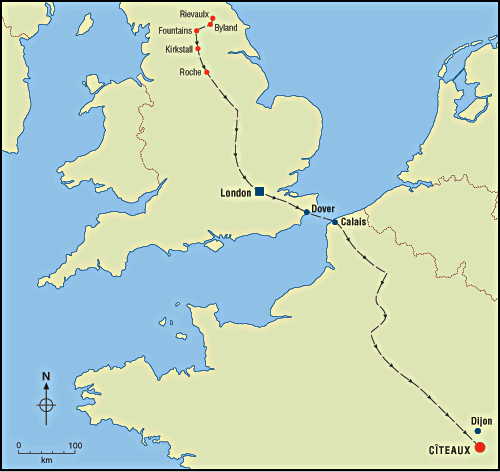|
|
You are here:
Cistercian administration: the General
Chapter
(2/4)
All heads of Cistercian houses gathered yearly
at Cîteaux around
Holy Cross Day (14th September) to discuss business relating to
the Order. At first this was simply a meeting of Cîteaux
and her four elder daughters (La Ferté, Pontigny, Morimund,
Clairvaux), but with the tremendous expansion of the Order it soon
became a large and truly international assembly. At the end of
the twelfth century the chapter-house at Cîteaux could accommodate
three hundred people. All heads of houses were expected to attend
this meeting to discuss disciplinary matters, issue new legislation,
and thereby effect the centralisation of the Order.
Map showing the route probably taken by the Yorkshire abbots travelling
to the General Chapter; after D. Williams, The Cistercians
in the Early Middle Ages, p 39.
<click
to enlarge>
|
|
The format
The abbots generally arrived on the ninth hour of the 13th September,
to prepare for the first day of the Chapter on the morrow, when
the delegates recapitulated the previous years’ legislation
and letters that had been received since the last meeting were
read aloud. On the second day, faults were examined before Sext,
and several abbots were then appointed as definators to draw
up the Statutes; in later years the definators acted as a steering
committee, arbitrating over disagreements where necessary. Sermons
and prayers for the dead were said on the third day, and over
the following three or four days disciplinary problems and requests
to the Chapter, such as those from houses seeking affiliation,
were investigated and discussed. On the final day, prayers for
earthly rulers and protectors were said and the agreed statutes
promulgated. The abbots then left on their long and often precarious
journey home. Upon their return to their own abbeys they read
the statutes to their community, which were then stored for future
reference and read on three more occasions throughout the year.
Attendance
Attendance at the General Chapter was compulsory, although
those who were ill were excused, providing that they sent a letter
of explanation and a deputy. Dispensation might be granted to abbots
living in remote parts, who had an exceptionally long and arduous
journey – it was agreed in 1157 that the abbots of Scotland
should only attend once every four years and the same privilege
was conceded to the Irish abbots in 1190. The English abbots requested
this concession in 1201, but were turned down. Absenteeism was
not, however, uncommon, for the length of the journey, the expense
involved and the dangers of the roads deterred many from attending
the meeting. An abbot travelling from London journeyed for about
a month before arriving at Cîteaux, where he remained for
a week; his return journey and the time it took to travel to and
from London meant that he was away from his community for almost
three months of the year, a considerable period of absence.
<back> <next>
|







